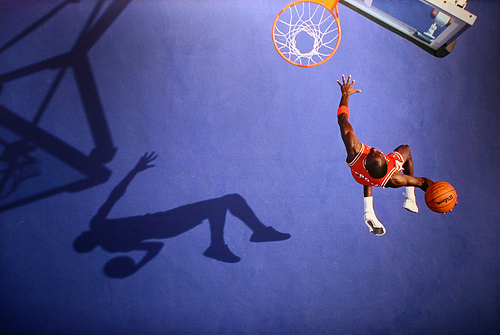Thinking about Dunking


Dunking is the highest percentage shot in basketball. More than that, it is the one action that many young players aspire to be able to do. Watching the world’s elite on television, the sheer awe that a dunk during a game produces is one of the truly griping aspects of the sport.
Players will develop at different rates in younger age groups especially there will be a huge range of different abilities and maturity physically. Typically many coaches do not instruct young developing players in regards to dunking the basketball. It is usually a skill that a player develops at least initially away from the practice court of team training sessions. However there are a number of teaching points to help athletes develop this skill just the same as every other shooting technique.
Two Feet or One Foot?
Players usually have a clear preference in regards to if they feel one foot or two feet is their preferred option for attempting a dunk. It is worth explaining though, that if a player attempts to take off on one foot then they will be able to achieve greater reach as they are able to raise the shoulder of the dunking arm higher.
This is in contrast to when jumping off two feet as players will usually use two hands and not have the ability to raise either shoulder, but must maintain a balanced position or lose control.
Golf and Tennis Ball
To help with players experiencing success when practicing their dunking as well as assisting in goal setting, it can help for players to use other balls initially. The use of Golf and Tennis balls can help with players practicing their dunking technique while still working their way up to using a full size six or seven basketball.
Grabbing the Rim
Players new to dunking may find a tendency to grab onto the basketball hoop when forcing the basketball. The technique here is for the athlete to push the ball into the basket, without grabbing the rim. Rather their hand should slide off the hoop.
It is worth noting here that some outdoor or poorly maintained basketball hoops can develop rough edges and cut a player’s hand when it comes in contact with the hoop. This injury is often more server when the hand is slid along the hoop.
Another issue with grabbing on the basket is that if a player holds onto the basket for any length of time their legs will sling out from under them because of their momentum. This can mean players lose control of their body and balance and make landing awkward, and sometimes dangerously.
Most facilities featuring basketball hoops have rules against players holding onto basketball hoops due to the damage that is commonly done by players through this practice.
Landing
Landing following the dunk can be challenging when first starting, but is still one of the more dangerous times for any player including those athletes at the highest levels. Landing on other players, running into basketball hoop fixtures or just poor technique can result in serious injury.
Players should attempt to land on two feet if possible and always land with their legs flexed at the knees to help absorb the shock of the landing. If landing on one leg the same principle applies to not land straight legged.
Dunking is a powerful technique for a capable player to master. A dunk during a game can be a momentum changing event. There are a few points which need to be kept in mind when instructing a player in performing this skill to help meet their goal of dunking in a safe way.


Dunking may be the highest percentage shot. But it sure is a plot twist seeing players miss a dunk.
It is a play that is all or nothing.